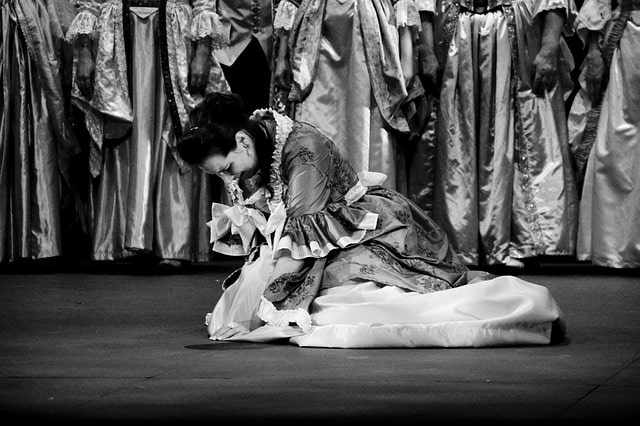Dramatic Theater – Definition, Concept and Entrepreneurship
Contents
What is dramatic theater?
Dramatic theater is a didactic plot that presents a series of loosely connected scenes that avoid illusion and often interrupt the story line to directly address the audience with analysis, argument, or documentation.
This theater is now most often associated with the dramatic theory and practice developed by playwright-director Bertolt Brecht in Germany beginning in 1920. Its dramatic antecedents include the episodic structure and didactic nature of pre-expressionist drama and expressionist theater in which exuberant use is made of technical effects.
Definition of Dramatic Theater
Dramatic theater has a plot or story and people come to the theater expecting the plot to be laid out before them and all events to be resolved at the end of the plot. The narrative begins and issues may be resolved or left unresolved, confronting the audience with questions about what they will do.

In this sense, Brecht thought that dramatic theater was entertainment, so in his opinion dramatic theater should engage the audience in an emotional experience only during their time in the theater. Likewise, dramatic theater has a linear narrative, meaning that its events happen in chronological order.
How did dramatic theater develop?
The first plays were performed with a single actor (called the protagonist) and a chorus of people who helped him tell the story. However, throughout the 5th century BC playwrights continued to innovate. The playwright Aeschylus added a second speaking role called the antagonist, and reduced the chorus from 50 to 12 singers, in his play The Persians, first performed in 472 BC, the oldest surviving of all Greek plays.
His disciple Sophocles added a third actor, while Euripides added a prologue, introducing the theme of the play, and the deus ex machina, a divine figure who attended to the aspects left loose at the end. Wealthy citizens sponsored the plays by paying a tax called the choregia. And like Pisistratus, the tyrant who established the city Dionysia to increase his own popularity, many of these wealthy patrons hoped that the success of the play they sponsored would provide them with a foothold in politics.
The first plays were performed at the Theater of Dionysus, built in the shadow of the Acropolis in Athens in the early fifth century, but the theaters proved so popular that they soon spread throughout Greece. Thus, drama was classified according to three different types or genres, comedy, tragedy and satyr plays.
Characteristics of dramatic theater
In this theater, drama is a piece of writing, which is artistically presented with dialogues. This drama is attractive, impactful and real as it presents the characters along with a natural and believable appearance, which is very similar to a short story as, it also comprises characters, plot, setting and symbolism.
In the dramatic theater process, creative efforts are coordinated under the direction of a theater director in which the playwright’s work is staged by the director with the actors, designers, technicians, dancers, musicians, and any other collaborators who join in the script, scenario, or plan.
The final product results from the amalgamation of the actors to complete the finished act of the script, scenario and plan, in union with all the collaborators in the process to create the finale, which is what the audience witnesses as they sit in the theater and watch the play. The physical presence of the audience can change a performance, inspire the actors and create expectations. The presence of live actors on stage in front of live audiences sets it apart from today’s movies and television.
Legacy of this Theater
Melodrama is one of the legacies of dramatic theater and one of the most popular forms of entertainment in the 19th century. Although it was often dismissed as a cultural product, there is a growing awareness of its importance in the history of dramatic theater, which influenced both film and television. Thus, the modern perception of the world, based on a diversity of sensational news and happy endings, is perhaps a modern trend in the conventions of melodrama.
The first use of the word melodrama in French was to mean a dramatic piece of music. So from the beginning, melo in melodrama actually implies drama with music. Likewise, the first time the word melodrama was used in English was to describe a play in 1802 and its Tale of Mystery by Thomas Holcroft which was based on a French melodrama.

Representatives of this Theater
In late medieval times, many cities had specific spaces dedicated to public theater. But, after the Reformation in the 16th century, a movement that opposed the authority of the Roman Catholic Church and all religious drama was suppressed. Then, licenses were granted to theater companies allowing them to rehearse and perform in public, provided they had the approval and patronage of a nobleman.
One of the greatest representatives of dramatic theater was William Shakespeare, born in 1564, who was a playwright who wrote 38 plays and numerous sonnets. It is not only the breadth of his work that makes Shakespeare the greatest British playwright, but the beauty and inventiveness of his language and the universal nature of his writing.
Shakespeare wrote many of his most famous plays for the Globe Theatre, which was erected in 1599 by the Lord Chamberlain’s Men. When the lease on the site of their theater, The Theatre, in Shoreditch ran out, the company decided to dismantle the wooden building and rebuild it on the south bank of the River Thames, renaming it The Globe.
